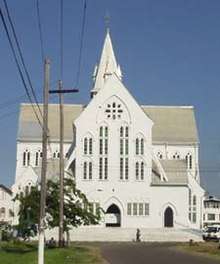Georgetown, Guyana
Georgetown is a city and the capital of Guyana, located in Region 4, which is also known as the Demerara-Mahaica region. It is the country's largest urban centre. It is situated on the Atlantic Ocean coast at the mouth of the Demerara River and it was nicknamed the "Garden City of the Caribbean".
Georgetown | |
|---|---|
  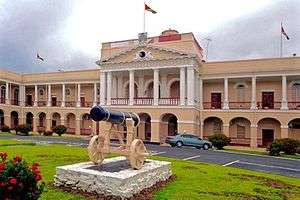 | |
 Georgetown Location in Guyana and South America 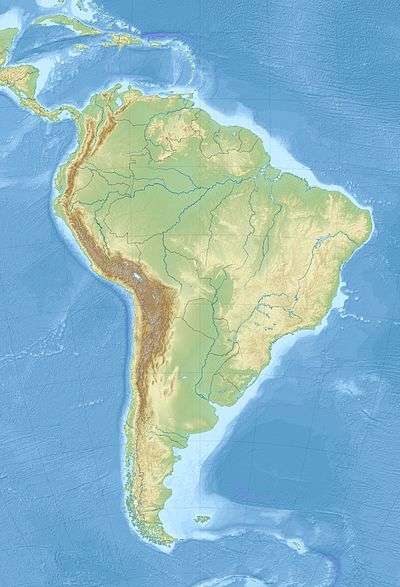 Georgetown Georgetown (South America) | |
| Coordinates: 6°48′4″N 58°9′19″W | |
| Country | |
| Region | Demerara-Mahaica |
| Established | 1781 |
| Named | 29 April 1812 |
| Government | |
| • Type | Mayor-Council |
| • Mayor | Ubraj Narine |
| Area | |
| • Total | 70 km2 (30 sq mi) |
| Elevation | 0 m (0 ft) |
| Population (2012)[1] | |
| • Total | 200,500 |
| • Density | 2,900/km2 (7,400/sq mi) |
| Time zone | UTC-4 |
| Area codes | 231, 233, 225, 226, 227 |
| Climate | Af |
Georgetown serves primarily as a retail and administrative centre. It also serves as a financial services centre. The city recorded a population of 200,500 in the 2016 census.[1]
History
_-_Copy.jpg)
The city of Georgetown began as a small town in the 18th century. Originally, the capital of the Demerara-Essequibo colony was located on Borsselen Island in the Demerara River under the administration of the Dutch. When the colony was captured by the British in 1781, Lieutenant-Colonel Robert Kingston chose the mouth of the Demerara River for the establishment of a town which was situated between Plantations Werk-en-rust and Vlissengen.
It was the French who made it a capital city when they colonized it in 1782. The French called the capital Longchamps. When the town was restored to the Dutch in 1784, it was renamed Stabroek after Nicolaas Geelvinck, Lord of Stabroek, and president of the Dutch West India Company. Eventually the town expanded and covered the estates of Vlissengen, La Bourgade and Eve Leary to the North, and Werk-en-rust and La Repentir to the South.
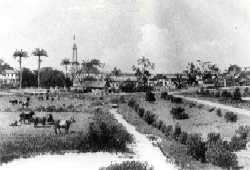
It was renamed Georgetown on 29 April 1812 in honour of King George III. On 5 May 1812, an ordinance was passed to the effect that the town formerly called Stabroek, with districts extending from La Penitence to the bridges in Kingston and entering upon the road to the military camps, shall be called Georgetown.
The ordinance provided that the various districts of Georgetown shall be known by their own names. The supervision of Georgetown was to be done by a committee chosen by the governor and Court of Policy. Estimates of expenditure were to be prepared.
By 1806, the owner of Vlissingen asked to be exempted from the responsibility of maintaining the road which is now called Camp Street, but the Court refused the request. In 1810, the maintenance of the roads in the area called Georgetown cost 11,000 guilders per annum.
The governing body of Georgetown was once a Board of Police. The Board of Police was chosen by the governor and the Court of Policy. It came into existence as the result of disputes among various organisations which controlled the districts. The board met monthly but what was discussed is not on the records between 1825 and 1837. Newspapers in the colony were prohibited by law from reporting public matters.
The post of Commissary of Police was not regarded as important. People elected to the board invariably declined to attend meetings and never gave reasons for their refusal. It was, therefore, decided that individuals elected to the board were bound to serve for two years, or suffer a penalty of 1,000 guilders. The Board of Police was abolished when an ordinance was passed to establish a mayor and town council.
Georgetown gained official city status on 24 August 1842 during the reign of Queen Victoria.
The names of Georgetown's wards and streets reflect the influence of the Dutch, French and English who administered the town at different periods of history.
Cummingsburg was originally named Plantation La Bourgade by its first owner, Jacques Salignac. It was laid out in streets and building lots by its second proprietor, Thomas Cuming, a Scotsman, from whom it gets its current name. He made a presentation of the Militia Parade Ground and Promenade Gardens to the town as a gift. Carmichael Street was named after General Hugh Lyle Carmichael who served as governor from 1812 to 1813. He died in March 1813 and was buried in the Officers' Cemetery, Eve Leary.
Water Street was so called because it ran along the riverside and formed the original river dam. High Street formed the leading road from the East Bank to the East Coast of Demerara. The part of High Street that ran through Cummingsburg was called Main Street. Camp Street received its name because it was the road which led to the camp or garrison at the northern end of the city. Kingston got its name from King George of England. It was part of Pln. Eve Leary which was named after the wife or daughter of its owner, Cornelis Leary. Some of the streets of Kingston have military names because the garrison used to be located there, e.g. Parade Street, Barrack Street and Fort Street.
Lacytown was another leasehold portion of Plantation Vlissengen. Luke M. Hill* states that it was named after the lessee, George Lacy, who was related to the family of General Sir De Lacy Evans (sic. - General Sir George de Lacy Evans GCB), a Crimean war hero. The owner of Vlissengen was Joseph Bourda, Member of the Court of Policy. After his son and heir disappeared at sea, the government claimed the property under the authority of the Vlissengen Ordinance of 1876. A new district of Bourda was laid out and Lacytown was improved by the Board of Vlissengen Commissioners.
Bourda Street and the ward of Bourda were named after Joseph Bourda, Member of the Court of Policy and former owner of Pln. Vlissengen. It was laid out by the Commissioner of Vlissengen in 1879. The Bourda Cemetery holds the remains of many citizens of Georgetown. Only those persons who owned family vaults or burial rights in the enclosed ground used it.
In 1945, a large fire (The Great Fire) broke out in the city, causing widespread damage.
- Reference: Luke M. Hill - The Nomenclature of Georgetown in Timehri: The Journal of the Royal Agricultural and Commercial Society of British Guiana (Third Series) Vol.1, January 1911, p. 42
Geography
.jpg)
Georgetown is located on Guyana's Atlantic coast on the east bank of Demerara River estuary. The terrain in this part of the country where the city is located is flat coastal plains. The city is surrounded by a blanket of cane fields along with marshy swamps, and savannah lands on its east and south. The elevation of the land is one metre below the high tide level. This low elevation is protected by a retaining wall known as the seawall to keep the ocean out and an innovative network of canals with kokers to drain the city of excess water. Guyana has ten administrative regions with four natural regions.
Climate
Georgetown has a year-round hot trade-wind tropical rainforest climate. Relative humidity fluctuates throughout the year with the highest occurring in May, June, August and December–January; these months are usually the rainiest part of the year. Between the months of September to November relative humidity is lower ushering in the drier season.
Georgetown does not truly have a dry season – monthly precipitation in all 12 months is above 60 millimetres (2.4 in). Because of its location Georgetown's temperatures are moderated by the North-East trade winds blowing in from the North Atlantic and so it rarely sees temperatures above 31 degrees Celsius.
| Climate data for Georgetown (1961–1990) | |||||||||||||
|---|---|---|---|---|---|---|---|---|---|---|---|---|---|
| Month | Jan | Feb | Mar | Apr | May | Jun | Jul | Aug | Sep | Oct | Nov | Dec | Year |
| Average high °C (°F) | 28.6 (83.5) |
28.9 (84.0) |
29.2 (84.6) |
29.5 (85.1) |
29.4 (84.9) |
29.2 (84.6) |
29.6 (85.3) |
30.2 (86.4) |
30.8 (87.4) |
30.8 (87.4) |
30.2 (86.4) |
29.1 (84.4) |
29.6 (85.3) |
| Daily mean °C (°F) | 26.1 (79.0) |
26.4 (79.5) |
26.7 (80.1) |
27.0 (80.6) |
26.8 (80.2) |
26.5 (79.7) |
26.6 (79.9) |
27.0 (80.6) |
27.5 (81.5) |
27.6 (81.7) |
27.2 (81.0) |
26.4 (79.5) |
26.8 (80.2) |
| Average low °C (°F) | 23.6 (74.5) |
23.9 (75.0) |
24.2 (75.6) |
24.4 (75.9) |
24.3 (75.7) |
23.8 (74.8) |
23.5 (74.3) |
23.8 (74.8) |
24.2 (75.6) |
24.4 (75.9) |
24.2 (75.6) |
23.8 (74.8) |
24.0 (75.2) |
| Average rainfall mm (inches) | 185.2 (7.29) |
88.5 (3.48) |
111.0 (4.37) |
140.5 (5.53) |
285.5 (11.24) |
327.7 (12.90) |
268.0 (10.55) |
201.4 (7.93) |
97.5 (3.84) |
107.2 (4.22) |
185.9 (7.32) |
261.9 (10.31) |
2,260.3 (88.99) |
| Average rainy days (≥ 1.0 mm) | 16 | 10 | 10 | 12 | 19 | 23 | 21 | 15 | 9 | 9 | 12 | 18 | 174 |
| Mean monthly sunshine hours | 201.0 | 208.6 | 219.7 | 197.9 | 178.8 | 156.7 | 201.6 | 233.7 | 229.8 | 235.3 | 210.9 | 186.6 | 2,460.6 |
| Source: NOAA[3] | |||||||||||||
The capital city
.jpg)
Georgetown is the seat of the central Government of Guyana. All executive departments are located in the city. Parliament Building, Guyana's Legislative Building, is also found in Georgetown and so is the Court of Appeals, Guyana's highest judicial court.
The State House (the official residence of the head of state), as well as the offices and residence of the head of government, are both located in the city. Georgetown is the capital city as well as the main economic base of Guyana.
Economy
Georgetown is Guyana's largest urban centre, containing a large portion of its commerce. Within the metro area there is the CARICOM headquarters, the Administrative Arm of the Caribbean Regional Integration Organisation. Georgetown also is home to a seaport. Guyana's international airport, Cheddi Jagan International Airport/Timehri, an hour south of Georgetown is a destination for Caribbean Airlines (the airline formerly known as BWIA or ""bwee""), META and Travel Span GT.
Closer to the city is the newly expanded Ogle Airport, with a terminal facility geared to handle regional, international and inter-Caricom flights, connecting CARICOM states with the CARICOM Secretariat. The city has many highway projects under construction although the four-lane East Coast Highway was completed in 2005. Georgetown accounts for a large portion of Guyana's GDP.
Transportation
The Cheddi Jagan International Airport (formerly Timehri Airport) acts as the major air transportation hub for the city, which is located on the right bank of the Demerara River, 41 kilometres south of Georgetown. Direct international flights as well as connecting service from New York City, Miami, Toronto, Panama City, Panama, Bridgetown, Port of Spain, Paramaribo, Aruba and Curaçao are flown. All scheduled passenger jet service for Georgetown is operated via this international airport.
Close-in Ogle Airport also serves Georgetown. Helicopters also use this airport for support of offshore oil and gas exploration activities.
There is a regular coach service between Georgetown and Boa Vista in Brazil, and once-daily connections to Paramaribo, Suriname via a ferry crossing on the Corentyne River. Transportation can be by bus, car, or boat. The Demerara Harbour Bridge is a major crossing point. The Berbice Bridge located to the east near New Amsterdam, Guyana is also transfer point to get to Georgetown or anywhere else. Most of the West Coast, East Bank, East Coast and Berbice, Guyana are served by numerous private buses. Taxi service is available almost everywhere along the coast including in large numbers in Georgetown. A number of highways have been newly constructed and the government is working to rehabilitate all roads in the country.
Demographics
Georgetown recorded a population of 118,363 in the 2012 Guyanese census, down 12 percent from the 134,497 people counted in the 2002 census.[1] In 2002, about 70,962 (53%) listed themselves as Black/African; 31,902 (24%) as mixed; 26,542 (20%) as East Indian; 1,441 (1.1%) as Amerindian; 1075 (0.8%) as Portuguese; 475 (0.35%) as Chinese; 2,265 (1.7%) as "don't know/not stated"; 196 (0.15%) as white not of Portuguese descent; 35 as "other".[6]
Points of interest
Georgetown is laid out in a north–south, east–west grid, interlaced with canals protected by kokers (sluices), built by the Dutch and later the British that provide drainage to a city that lies 0.91 metres (3 ft) below high-tide level. A long sea wall helps prevent flooding. The city has numerous boulevards and contains many wooden colonial buildings and markets.
Most of the main buildings are centred around the western region of the town. Around the western-central area is Independence Square and Promenade Gardens, the Walter Roth Museum of Anthropology, the National Library (built by Andrew Carnegie), the Bank of Guyana, Company Path Garden, the National Museum of Guyana and State House (built 1852) where the president resides, and St. George's Anglican Cathedral. There are many churches, mosques and mandirs in Georgetown.
The Georgetown Cenotaph, at Main and Church Streets, was built in 1923. It is the site of Remembrance Day (Remembrance Sunday) services in November each year.
To the south of this region is where the neo-Gothic City Hall (1889) is to be found, as well as the Victoria Law Courts (1887), the Parliament Building (1829–1834), the large Stabroek Market (1792) containing the prominent cast-iron clock tower that dominates the city sky line, the Roman Catholic Brickdam Cathedral, City Engineer House, the Magistrate's Court, St. Andrew's Kirk (1818) and Independence Arch.
The northern area of the city near the Atlantic coast contains Splashmins Fun Park, Fort William Frederick, a park and the Umana Yana, a conical thatched building built by Wai-Wai Amerindians using traditional techniques. It was built for the 1972 Non-Aligned Foreign Ministers Conference. The Umana Yana burnt down in 2010 but was rebuilt in 2016.[7] The Georgetown Lighthouse is a famous landmark.
The City is protected from the Atlantic Ocean by the Seawall and Shell Beach. The Guyana National Park is nearby. More inland, surrounded by residential neighbourhoods are the Guyana Zoo, Botanical Gardens and Castellani House.
Georgetown is the seat of the University of Guyana and the Caribbean Community (CARICOM) Secretariat which are both located at Turkeyen, on the city's outskirts.
Tourism
There are many tourist attractions in Georgetown, including St. George's Anglican Cathedral and Stabroek Market.
Performing arts
%2C_performs_at_the_National_Cultural_Centre.jpg)
Georgetown's theatre scene is dominantly concentrated on the stages of the National Cultural Centre. Plays are also staged at the theatre guild of Guyana. This is the oldest theatrical performance facility in Guyana. It was opened in 1957 and restored in 2007.
Regions of Georgetown
Georgetown has expanded dramatically through the years and may be divided into three Geographical regions:
Georgetown – referring to Central Georgetown includes the Business district as well as the seat of the national Government.
Greater Georgetown – contains some of the most expensive and luxurious metropolitan neighbourhoods. Bel Air Park, Bel Air Gardens, Lamaha Gardens and Bel Air Springs are well known ultimately as places for the rich and powerful. Most residents here are high ranking executives or government officials. These close gated neighbourhoods of the city are mostly concentrated in the northeastern part towards Greater Georgetown and the Atlantic.
Greater Georgetown contains some notable places such as:
- The University of Guyana (Headquarters)
- The Cyril Potter College of Education
- The Caribbean Community Secretariat (Headquarters of CARICOM)
- The Guyana International Conference Centre
- Ocean View International Hotel
- Guyana Sugar Corporation (Headquarters of the country's largest corporation)
- Ogle Airport (Guyana's local air transport facility)
South Georgetown – incorporated communities of neighbourhoods along the eastern bank of the Demerara River such as Sophia, Roxanne Burnham Gardens, Albouystown, and Agricola. Those are well known and highly regarded poor areas of the city. Some areas such as Houston Estates, Ruimvelt and Thirst Park have retained high levels of affluence.
City neighbourhoods
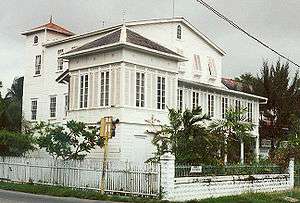
Known for its historic importance, Georgetown remains the administrative centre for the central Government.
North of Georgetown lies Main Street, where the head of state's official residence can be found along with several other important Government buildings, including the Ministry of Finance. East of Georgetown stretches towards the Avenue of the Republic, where Georgetown's city hall building is located, as well as the St. George's Cathedral. Also on the east side is Brickdam, which is the single most concentrated area of executive departments and agencies. The Ministries of Health, Education, Home Affairs, Housing and Water are all located on Brickdam.
West of Stabroek Market is the Port of Georgetown, the largest and busiest shipping point in Guyana. Stabroek Market itself contains the Ministry of Labour as well as the Ministry of Human Services and Social Security. It is also the host facility for the equally famous Stabroek markets.
- Regent Street – Georgetown's premier shopping district.
- Sheriff Street – Guyana's main entertainment area; contains most of the city's clubs, bars and restaurants.
Suburbs

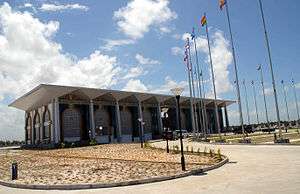
Suburban Georgetown consists of Greater Georgetown and Uptown Georgetown and contains the following suburbs of the city:
- Republic Park
- Nandy Park
- Providence
- Felicity
- Bel Air
- Vreed en Hoop
- Kingston
- Queenstown
- Alberttown
- Subryanville
- Lamaha Gardens
Sports
Georgetown hosted the CaribeBasket, the top international basketball tournament for countries in the Caribbean in 1981, 1988 and 1994.
Crime
Armed robberies occur regularly in Georgetown, especially in businesses and shopping districts.[8] Particularly high crime areas of Georgetown include Tiger Bay, Albouystown, Sophia, all of south Georgetown, Buxton and Agricola.[9] Robberies are a daily occurrence in the Stabroek Market area.[9] A number of assaults have taken place in the botanical garden.[9]
Utilities
- Power is supplied by the state-owned and controlled Guyana Power and Light.
- Water and solid waste disposal is handled by state-owned Guyana Water Incorporated.
- Telephone and high-speed Internet access are supplied by U.S.-owned Guyana Telephone & Telegraph Company.
- Cellular services are also provided by Digicel and U.S.-owned Guyana Telephone & Telegraph Company.
- Satellite television services are offered by Sky Digital Networks (Guyana) Inc.
- Satellite television services are offered by DirecTV Caribbean.
- Wireless Internet and Communication services are provided by Java Technologies and Globespan Technology.
Notable people
- Julian Austin (1949), hockey player[10]
- Sudesh Fitzgerald, professional darts player, born in Georgetown
- Lance Gibbs (born 1934), former member of the West Indies cricket team[11]
- R. B. Greaves, an American singer born in Georgetown, Guyana
- Wilson Harris, Guyanese writer
- Roger Harper (born 1963), former member of the West Indies cricket team[12]
- Carl Hooper (born 1966), former member of the West Indies cricket team[13]
- Donald Kayum (born 1955), cricketer
- Clive Lloyd (born 1944), captain West Indies cricket team[14]
- Thomas Moulder (1872–1920), cricketer
- C. C. H. Pounder, a Guyanese-American actress, born in Georgetown
- Walter Rodney, historian of Africa, born in Georgetown, Guyana
- C. M. Rubin, children's book writer, born in Georgetown
- Dušan Velkaverh, Slovenian lyricist, born in Georgetown, Guyana
- Oscar Weber (1871–1946), cricketer
- Letitia Wright, a Guyanese actress, born in Georgetown
Twin towns – sister cities
Georgetown has several sister cities, as designated by Sister Cities International:


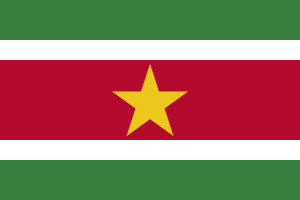
References
- Guyana Population and Housing Census 2012: Preliminary Report (Report). Bureau of Statistics, Guyana. June 2014. p. 23. Retrieved 23 May 2016.
- "Wesleyan Mission Premises, George-Town, Demerara". Wesleyan Juvenile Offering. London: Wesleyan Methodist Missionary Society. VII: 1. January 1850. Retrieved 19 November 2015.
- "Georgetown Climate Normals 1961–1990". National Oceanic and Atmospheric Administration. Retrieved 23 April 2015.
- "Electricity Rates | GPL Inc". GPL Inc. 1 February 2008. Archived from the original on 7 June 2011. Retrieved 30 April 2010.
- "Impact of Increased Cost of Living in Guyana". Baiganchoka. 17 April 2008. Archived from the original on 29 July 2012. Retrieved 30 April 2010.
- "Bureau of Statistics – Guyana". Statisticsguyana.gov.gy. Retrieved 30 April 2010.
- Gxmedia (29 April 2019). "Umana Yana is standing strong and continues to be one of Georgetown's most scenic attraction". Things Guyana.
- "Guyana 2014 Crime and Safety Report", Overseas Security Advisory Council, US State Department, 15 August 2014.
- "Safety and security - Guyana travel advice".
- "Julian Austin". Olympic Canada. Retrieved 11 August 2020.
- "Lance Gibbs". espn circinfo. Retrieved 11 August 2020.
- "Roger Harper". espn circinfo. Retrieved 11 August 2020.
- "Carl Hooper". espn circinfo. Retrieved 11 August 2020.
- "Sir Clive Lloyd". espn circinfo. Retrieved 11 August 2020.
External links
- Outsourcing in Georgetown, Guyana from news publication, Nearshore Americas.
- Site with photos and maps of Guyana and Georgetown
- Georgetown Chamber of Commerce & Industry
- The Tramways of Georgetown, British Guiana
- Article about the 1945 fire, with images
- Article: Guyana's Capital, Tropical Victorian

- . Collier's New Encyclopedia. 1921.
- . . 1914.
